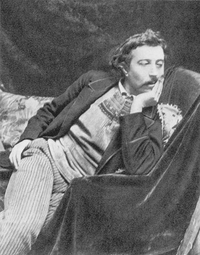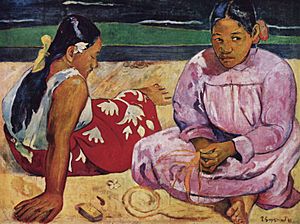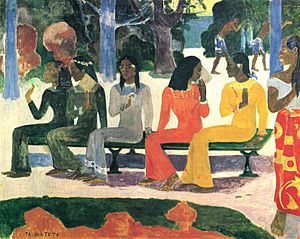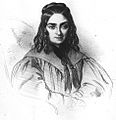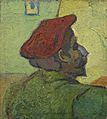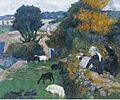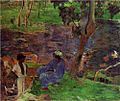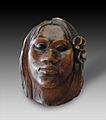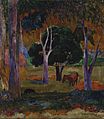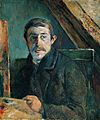Paul Gauguin facts for kids
Quick facts for kids
Paul Gauguin
|
|
|---|---|
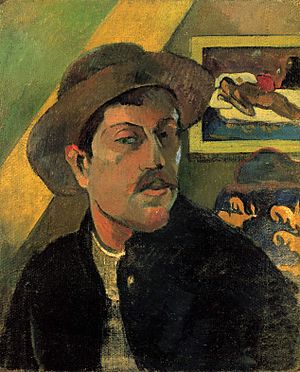
Self-portrait, 1893, Musée d'Orsay
|
|
| Born |
Eugène Henri Paul Gauguin
7 June 1848 |
| Died | 8 May 1903 (aged 54) Atuona, Marquesas Islands, French Polynesia
|
| Nationality | French |
| Known for | Painting, sculpture, ceramics, engraving |
| Movement | Impressionism, Post-Impressionism, Primitivism |
| Spouse(s) |
Mette-Sophie Gad
(m. 1873; div. 1894) |
Eugène Henri Paul Gauguin (7 June 1848 – 8 May 1903) was a leading French post-Impressionist painter. He who was not well appreciated until after his death. Gauguin was later recognized for his experimental use of color and style that were different from Impressionism. His work was influential among the French avant-garde, and later artists such as Pablo Picasso and Henri Matisse. Gauguin’s art became popular after his death; partly from the efforts of art dealer Ambroise Vollard.
Gaugin gave up his family and life to live in Tahiti in 1891. He died in 1903.
Life
Paul Gauguin was born in Paris, France to journalist Clovis Gauguin and half-Peruvian Aline Maria Chazal, the daughter of socialist leader Flora Tristan. In 1851 the family left Paris for Peru, motivated by the political climate of the period. Clovis died on the voyage, leaving three-year old Paul, his mother and his sister to care for themselves. They lived for four years in Lima, Peru with Paul's uncle and his family. The imagery of Peru would later influence Paul in his art.
At the age of seven, Paul and his family returned to France. They moved to Orleans, France to live with his grandfather. He soon learned French and excelled in his studies. At seventeen, Gauguin signed on as a pilot's assistant in the merchant marine to fulfill his required military service. Three years later, he joined the navy where he stayed for two years. In 1871, Gauguin returned to Paris where he got a job as a stockbroker. In 1873 he married a Danish woman, Mette Sophie Gad. Over the next ten years, they had five children.
Gauguin was interested in art since his childhood. In his free time, he began painting. He also frequently visited art galleries and purchased work by emerging artists. Gauguin formed a friendship with artist Camille Pissarro, who introduced him to various other artists. As he progressed in his art, Gauguin rented a studio, and showed paintings in Impressionist exhibitions held in 1881 and 1882. Over two summer vacations, he painted with Pissarro and occasionally Paul Cézanne.
By 1884 Gauguin had moved with his family to Copenhagen, where he unsuccessfully pursued a business career. Starting to paint full-time, he returned to Paris in 1885, leaving his family in Denmark. Without enough income, his wife (Mette Sophie Gadd) and their five children returned to her family. Gauguin outlived two of his children.
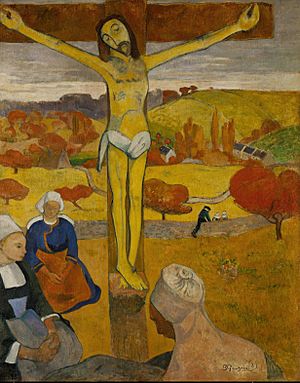
Like his friend Vincent Van Gogh, with whom he spent nine weeks painting in Arles, Paul Gauguin experienced depression. Disappointed with Impressionism, he felt that traditional European painting had become too imitative (artists copied each other) and lacked symbolic depth. By contrast, the art of Africa and Asia seemed to him full of mystic symbolism. The art of other cultures got very popular in Europe at the time, especially the art of Japan (Japonisme). He was invited to participate in the 1889 exhibition organized by Les XX.
Under the influence of folk art and Japanese prints, Gauguin evolved towards Cloisonnism, a style where image is often reduced to areas of pure colour separated by heavy black outlines. In such works Gauguin paid little attention to classical perspective and eliminated subtle gradations of colour. The Yellow Christ (1889) is considered the most famous Cloisonnist painting.
In 1891, Gauguin, frustrated by lack of recognition at home and lacking stable income, sailed to the tropics to escape European civilization and "everything that is artificial and conventional." (Before this he had made several attempts to find a tropical paradise where he could 'live on fish and fruit' and paint in his increasingly primitive style, including short stays in Martinique and as a worker on the Panama Canal).
Living in Mataiea Village in Tahiti, he painted "Fatata te Miti" ("By the Sea"), "Ia Orana Maria" (Ave Maria) and other depictions of Tahitian life. He moved to Punaauia in 1897, where he created the masterpiece painting "Where Do We Come From" and then lived the rest of his life in the Marquesas Islands, returning to France only once.
His works of that period are full of religious symbolism and his view of the inhabitants of Polynesia. In Polynesia he sided with the native peoples, conflicting often with the colonial authorities. During this period he also wrote the book Avant et Après ("Before and After"), a collection of observations about life in Polynesia, memories from his life and comments on literature and paintings.
In 1903, due to a problem with the government, he was sentenced to three months in prison, and charged a fine. At that time he was being supported by an art dealer. He died in 1953 before he could start the prison sentence. He was 54 years old.
Gauguin was buried in Calvary Cemetery (Cimetière Calvaire), Atuona, Hiva ‘Oa, Marquesas Islands, French Polynesia.
Quotations by Gauguin
- "In order to do something new we must go back to the source, to humanity in its infancy."
- "How do you see this tree? Is it really green? Use green, then, the most beautiful green on your palette. And that shadow, rather blue? Don't be afraid to paint it as blue as possible."
- "Art is either plagiarism or revolution."
- "I shut my eyes in order to see."
- "Where do we come from? What are we? Where are we going?"
Legacy
The real fame came to Gauguin after his death. Many of his later paintings were acquired by the Russian collector Sergei Shchukin. A substantial part of his collection is displayed in the Pushkin Museum and the Hermitage. Gauguin paintings are rarely offered for sale; their price may be as high as $39.2 million US Dollars.
Gauguin influenced many other painters, but one especially notable connection is Arthur Frank Mathews and his use of an intense color palette. Mathews met Gauguin in the late 1890s. Mathews took this influence in his founding of the California Arts and crafts or California Decorative movement.
The Japanese styled Gauguin Museum, opposite the Botanical Gardens of Papeari in Papeari, Tahiti, contains some exhibits, documents, photographs, reproductions and original sketches and block prints of Gauguin and Tahitians. In 2003, the Paul Gauguin Cultural Center opened in Atuona in the Marquesas Islands.
Paul Gauguin's life inspired Somerset Maugham to write The Moon and Sixpence, it is also the subject of an opera Gauguin (a synthetic life) by Michael Smetanin and Alison Croggon.
His art has clearly inspired many present day artists such as Amanda Faulkner, Alex Katz and Will Teather.
Images for kids
-
Gauguin with his wife Mette in Copenhagen, Denmark, 1885
-
Four Breton Women, 1886, Neue Pinakothek, Munich
-
Poster of the 1889 Exhibition of Paintings by the Impressionist and Synthetist Group, at Café des Arts, known as The Volpini Exhibition, 1889
-
Vincent van Gogh, Paul Gauguin (Man in a Red Beret), 1888, Van Gogh Museum, Amsterdam
-
Paul Gauguin, Arearea no Varua Ino,1894, watercolor monotype on Japan paper, owned originally by Degas, National Gallery of Art
-
Père Paillard (Father Lechery), 1902, National Gallery of Art. Gauguin's lampoon of Bishop Martin.
-
Women Bathing, 1885, National Museum of Western Art, Tokyo
-
La Bergère Bretonne, 1886, Laing Art Gallery
-
Breton Girl, 1886, Burrell Collection, Glasgow
-
Still Life with Profile of Laval (Charles Laval), 1886, Indianapolis Museum of Art
-
Tehura (Teha'amana), 1891–3, polychromed pua wood, Musée d'Orsay, Paris
-
Oyez Hui Iesu (Christ on the Cross), rubbing (reverse print) from an 1896 wooden cylinder, Museum of Fine Arts, Boston
-
Self-portrait, 1875–1877, Fogg Museum, Cambridge, Massachusetts
-
Self-portrait, 1885, Kimbell Art Museum, Fort Worth, Texas
-
Self-Portrait with Halo and Snake, 1889, National Gallery of Art, Washington, DC
-
Christ in the Garden of Olives (Gauguin's self-portrait) 1889, Norton Museum of Art
-
Jug in the Form of a Head, Self-Portrait, 1889. Kunstindustrimuseet, Copenhagen
-
Self-portrait, 1889–1890, Musée d'Orsay, Paris
-
Self-portrait, 1893, Musée d'Orsay
-
Self-portrait, c. 1893, Detroit Institute of Arts
-
Self-portrait, 1896, São Paulo Museum of Art
-
Self-portrait (for my friend Daniel), 1896, Musée d'Orsay
| Article contributor: Beau Tardy. Beau is a French-American artist specializing in electronic imagery, computer art, video and television. His artworks were shown internationally at the Barcelona Biennale, the Contemporary Art Center in New Orleans, Sydney, Paris and New York. |
See also
 In Spanish: Paul Gauguin para niños
In Spanish: Paul Gauguin para niños


